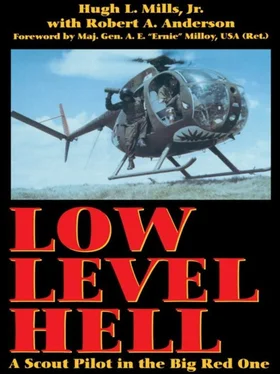The plight of the slick pilot was to sit on the ground and wait. Wait until the scout uncovered some sort of enemy activity that warranted the Cobra relaying the pulse-pounding call back to the base: “Scramble the ARPs!” Sometimes we took the ARPs directly into an LZ, but sometimes the order would be to just move the aerorifle platoon out of Phu Loi to another base closer to the point of action. After getting them to the new location, we’d just shut down the aircraft and wait for the possibility of a later call to move them into the action zone.
So, again, we’d wait. We’d read, sleep, maybe crawl up on the doghouse of the Huey to get a little suntan. And wait.
By the middle of March ‘69, being a slick driver looked as though it might become my life’s profession. Not a day passed that I didn’t wonder if Major Cummings had forgotten all about moving me to scouts. But while I was flying slicks, and wishing for scouts, I was learning. I was getting some in-country experience that helped me dry out a bit behind the ears.
I was becoming familiar with the 1st Division’s tactical area of operational responsibility (TAOR). Vietnam’s III Corps geography (war zones C and D) was getting pretty familiar to me: from the city of Saigon, the Dog Bone, and VC Island in the south to, roughly, Phuoc Vinh on the east, the Cambodian Parrot’s Beak and Fishhook to the west on up to the Cambode border on the north.
And I learned about going into hot LZs with enemy AK rounds tearing through the airframe, staying “in trail” while all hell broke loose around you. Though I desperately wanted out of Hueys and into OH-6s, I knew that I’d never sell slick pilots short on raw determination and basic courage. Slicks were not gunships. They weren’t equipped with the firepower to deal with an enemy trying to shoot you out of the sky. The mission was to breach the enemy ground fire, stay in trail formation, touch down in that LZ long enough for the ARPs to jump out of the ship (usually no longer than about three seconds), and then get the hell out of Dodge. At fifteen hundred feet or more, where ground fire wasn’t a hazard, most Huey pilots kept their seats adjusted high enough to see well out of the cockpit. But as their ships hit final into the landing zone, the pilots would pop the vertical adjustment so that the seat dropped down inside the seat armor plate. When the seat was all the way down, the top of the armor shield was just about at eye level—eyeball defilade, we called it. Then, when enemy rounds cracked through the aircraft, only your legs, part of your arms, and the top of your head were outside the armor plate. The front of your body was protected by the “chicken plate,” and the .45 holster, tucked neatly between your legs, protected your masculinity.
In addition, I learned how to plot and call artillery strikes on a hostile target to neutralize the area before taking a flight of Hueys into the landing zone. And, on the ground, I also gained fame as the greatest rat killer in the history of hootch number 28, having some legendary face-offs with the very large Vietnamese rodent.
But there was one thing I never did learn while I was flying slicks. That was how to be patient when I saw the hunter-killer teams taking off to scout out and lay destruction on the enemy. I didn’t want to just react to the enemy. I wanted to be out there finding the enemy and laying the point of the bayonet to him.
During the days that I was flying Hueys, John Herchert was in and out of my hootch every once in a while. Herchert was commanding officer of the scout platoon, the Outcasts.
One day Herchert stopped by my bunk to tell me that one of his scout pilots had been hurt and there would be an opening in the platoon. “I need a section leader,” he told me. “If you still want to fly scouts, we’ve got a job for you.”
My transfer from slicks to the scout platoon was made on 23 March 1969. I had finally made it to the Outcasts!
The instructor pilot for the OH-6, CW2. Bill Hayes, was off on R and R for a few days when I was transferred, so I started my OH-6 orientation with scout pilots Bill Jones (One Eight) and Jim Morrison (One Four). I had a lot to learn.
The OH-6 had a personality all her own. She was light, nimble, and extremely responsive to every control input. While the Huey was stable, dependable, kind of like the faithful family sedan, the OH-6 was like getting a brand-new MGA Roadster. She was sexy!
The ship was unusually quiet in flight, giving her the added advantage of being practically on top of a potential enemy before anyone on the ground even knew a helicopter was around.
By design, the OH-6 was small and cramped. Her mission gross weight was just over 2,160 pounds. With the main rotor extended, she was only 30 feet, 3 3/4 inches long, and at the pilot’s cabin just a fraction over 4 1/2 feet wide. Not much space for two pilot seats side by side, with an instrument console in between.
There was room inside for just three people—the crew chief-door gunner on the right side of the rear cabin, the pilot in the right front seat, and the copilot-observer in the left front seat.
In combat configuration, the crew chief’s jump seat in the back was rigged so that the gunner sat sideways facing the open right rear cabin door. His M-60 hung in front of him from a bungee cord. Having no seat belt harness per se, the crew chief had a “monkey strap” that secured him to the aircraft but allowed him to move around the cabin.
Vulnerable as he was to ground fire from the bottom and into both sides of the aircraft, the crew chief sat in a canvas jump seat, the underside of which was fitted with a tungston carbide armor plate. He also wore two chicken plate body armor units, one shielding his chest and the other covering his back. The chicken plate body armor for aircrewmen consisted of a curved ceramic fiberglass shell over a tungston carbide inner liner. This ballistic barrier was capable of defeating up to 7.62mm small-arms fire (such as AK-47 enemy rounds), but nothing as large as .50-caliber projectiles.
Under Herchert’s system of flying three-man scout crews, each crew member had his own area of responsibility. The pilot basically flew the airplane. The crew chief, in the backseat right behind the pilot, was the door gunner and the crewman responsible for releasing grenades out the door. The various types of grenades were lined up on a wire strung across the back of the pilot’s armor plate. These usually included several colors of smoke, Willie Pete (white phosphorous), and concussion and fragmentation grenades. Besides his M-60, the crew chief might also have other ordnance stowed around and under his seat, such as an M-79 grenade launcher, a shotgun, and an M-16 rifle. The experienced crew chief also helped with the scouting work on the right side of the aircraft in support of the pilot, who had to split his scouting mission between watching forward and sideways to the right while at the same time flying the aircraft.
The observer had the visual responsibility for the left side of the aircraft, from about twelve o’clock to his front to eight or eight-thirty behind. Strapped into the copilot’s seat, it was difficult for him to see very far over his left shoulder toward the rear of the ship, but there was an excellent view to the immediate left and left forward. Scout ships flew without doors, so there was an uninterrupted field of vision.
The observer carried a weapon that he could fire out the left side. This was in lieu of minigun units, which were not mounted on Herchert’s OH-6s. Some left-seaters had a standard M-60, but that weapon was less than satisfactory because of its weight and the fact that it would jam easily when fired with its casing ejector pointed against the air-stream. So most observers used M-16s or CAR-15s. The CAR-15 was shorter and easier to handle. Both the M-16 and CAR-15 resisted jamming because they were magazine fed from the bottom of the weapon and not affected by the force of the airstream.
Читать дальше












